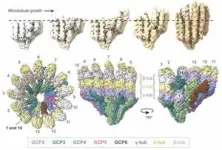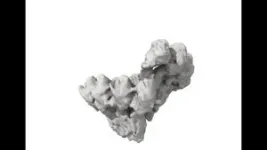(Press-News.org) · Researchers at the Centre for Genomic Regulation (CRG) , the Spanish National Cancer Research Center (CNIO) and the IBMB-CSIC solve a key problem in biology: how human cells build their microtubules
· During cell division, microtubules function as nanometer-thick long ‘ropes' inside cells that pull chromosomes apart so that each daughter cell receives a copy of the genetic material
· The work published in Science lays the groundwork for future breakthroughs in the treatment of diseases ranging from cancer to neurodevelopmental disorders
Cells in the human body are constantly dividing. With each division the genetic information contained in the chromosomes is duplicated, and each daughter cell receives a complete copy of the genetic material. It is a sophisticated process, a clockwork mechanism that involves refined and fast changes within the cell. To make this possible, the cell relies on microtubules, tiny structures that are indeed tube-shaped. Understanding how they start forming is a long-standing question.
Now, for the first time, researchers at the Centre for Genomic Regulation (CRG), the Spanish National Cancer Research Center (CNIO) and the Spanish National Research Council (IBMB-CSIC) have succeeded in making the equivalent of a film showing how human cells initiate the construction of their microtubules.
The findings, published today in the journal Science, solve a problem brought up years ago and thus lay the groundwork for future breakthroughs in the treatment of diseases ranging from cancer to neurodevelopmental disorders.
Long ropes that pull chromosomes apart
Óscar Llorca, director of the Structural Biology Program at the CNIO and co-lead author of the study, describes what happens inside the cell when cell division begins: "The chromosomes, once they have duplicated genetic information, move to the center of the cell and the cell, in a very remarkable way, quickly sprouts from its two ends large tubes that hook the chromosomes and pull each of the copies towards the two poles of the cell. Only then is it possible to encapsulate a copy of all our genetic material in each daughter cell."
The structures that are launched "like long ropes that reach the chromosomes to divide them," explains Llorca, are the microtubules. "That's why we say that microtubules play a key role in cell division. We need to understand very well the mechanisms that trigger the formation of these microtubules, at the right place and at the right time."
They are also 'cellular highways'
Microtubules are tubes with a length of thousandths of a millimeter and a diameter of nanometers [millionths of a millimeter]. In addition to being key to cell division, they act as highways for moving cellular components between different areas of the cell. They are also structural elements that shape the cell itself, among other tasks. A good understanding of their formation has implications for multiple areas of biomedicine.
"Microtubules are critical components of cells. Here we capture the process in action inside human cells. Given the fundamental role of microtubules in cell biology, this could eventually lead to new therapeutic approaches for a wide range of disorders," explains ICREA Research Professor Thomas Surrey, CRG researcher and co-lead author of the paper in Science.
Molecular ring triggers microtubule formation
The high-resolution images now obtained answer a question that has been hanging in the air for years: how microtubule formation begins in the early stages of cell division.
We now know that it all starts when a complex structure made up of several proteins, and called g TuRC (pronounced 'gammaturc'), closes, forming a ring.
The shape of g TuRC, its three-dimensional structure, was discovered a few years ago, and it surprised researchers. It was expected that g TuRC would be a closed ring acting as a base mold on top of which the microtubule is built; but g TuRC appeared as an open ring. Its dimensions and shape were incompatible with those of a microtubule mold.
The new CRG and CNIO work unveils the mechanism by which g TuRC closes into a ring and effectively becomes a perfect mold, capable of launching microtubule formation. The closure of g TuRC occurs when the first molecular piece of a microtubule gets attached to it.
"That's the trick the cell uses to close g TuRC," explains Llorca. "As soon as this first brick enters, a region of g TuRC is able to hook it and, like a loop, acts as a latch that pulls the ring closed and launches the process."
Visualizing this process required purifying g TuRC from human cells and reproducing the microtubule initiation process in the test tube. The samples were observed with cryo-electron microscopes and artificial intelligence was used for data analysis.
One million frames in a movie at atomic scale
One of the challenges has been to deal with the high speed of the microtubule construction process. The CRG group succeeded in slowing it down in the laboratory, and also stopping the growth of microtubules in order to better analyze the initial stages of the process.
"We had to find conditions that allowed us to image over a million microtubules in the process of nucleation before they grow too long and obscure the action of γ-TuRC. We were able to achieve this using the molecular toolbox of our lab and then freeze the microtubule stubs in place," explains Cláudia Brito, a postdoctoral researcher at the CRG and first author of the study.
The microtubules under construction were observed at the IBMB-CSIC's Electron Cryomicroscopy Platform, located at the Joint Electron Microscopy Center (JEMCA), inside the ALBA Synchrotron. "They were frozen in a thin layer of ice, preserving the natural shape of the molecules involved," explains Pablo Guerra, head of this Platform. That’s how the best experimental conditions for observing microtubules in formation were determined. The best frozen samples were then sent to BREM (Basque Resource for Electron Microscopy) for imaging, and the resulting images were transferred to Marina Serna and Oscar Llorca at the CNIO for analysis and determination of the three-dimensional structures at atomic resolution.
Artificial intelligence for assembly
In practice, having more than a million microtubules in different stages of growth is equivalent to having many frames of a movie in high resolution. You “just” have to arrange them in the right order to see the movie in progress. That task fell to the CNIO team, which used artificial intelligence techniques to complete it
“Determining the three-dimensional structure of growing microtubules from microscope images has been extremely complex. We needed multiple digital image-processing tools," explains Marina Serna, CNIO researcher.
For Llorca, "the great challenge has been to analyze at high resolution the images of a dynamic process, where we were observing several stages at the same time. This has been possible thanks to the use of neural networks, which have allowed us to organize all this complexity”.
The result are three-dimensional structures at atomic resolution that represent the different stages of how the construction of a microtubule begins, and how the γ-TuRC ring becomes the mold that launches the formation of microtubules.
Implications for health
As Llorca explains, "this finding is relevant because we have addressed a very basic mechanism of cell division, whose process in humans we did not know".
This basic knowledge is useful for learning how to correct errors in the functioning of microtubules, which are associated with cancer, neurodevelopmental disorders and other conditions ranging from respiratory problems to heart disease.
"Some of the drugs used today to treat cancer prevent the formation or dynamics of microtubules," says Llorca. "However, these drugs affect microtubules indiscriminately, both in cancer cells and in healthy cells, leading to side effects. Knowing in detail how microtubules are formed may contribute to the development of more targeted treatments that affect microtubule formation and allow progress in the treatment of cancer and other diseases."
Next step: understanding regulation
Thomas Surrey explains the next steps in understanding microtubules, which involve deciphering how microtubule formation is regulated: "The process of nucleation decides where the microtubules are in a cell and how many you have in the first place. It is likely that the conformational changes we observe are controlled by yet-to-be-found regulators in cells. Several candidates have been described in other studies, but their mechanism of action is unclear."
Further work, "clarifying how regulators bind to γ-TuRC and how they affect the conformational changes during nucleation, may transform our understanding of how microtubules work, and eventually offer alternative sites that one might want to target to prevent cancer cells from going through the cell cycle," Surrey concludes.
END
First atomic-scale 'movie' of microtubules under construction, a key process for cell division
2024-02-01
ELSE PRESS RELEASES FROM THIS DATE:
Mapping the structure and organization of hippocampal neurons in the mouse brain
2024-02-01
Single-cell projectome analysis has revealed previously unknown spatial organization principles of the brain-wide structure and connectivity of more than 10,000 individual hippocampal neurons in the mouse brain, according to a new study. Specialized projections called axons allow neurons to transmit signals to other neurons across the brain. The hippocampus (HIP) – one of the most extensively studied brain regions – plays a crucial role in many crucial brain functions, including learning, memory, ...
Large herbivores’ effects on ecosystems depend more on size and diet than on herbivore origin
2024-02-01
The effect of large herbivores on plant abundance and diversity depends more on their size and diet than whether they are native or introduced into their host ecosystems, according to a meta-analysis of more than 200 studies worldwide. The findings counter the widely held notion that the impacts of introduced megafauna are distinct and more harmful than those of native megafauna and suggest that trait-based ecology provides better insight into megaherbivore-plant interactions than concepts of species origin. Large mammal herbivores play a key role in shaping ecosystems and biodiversity by consuming vegetation, dispersing seeds and nutrients, and creating ...
The evolution of sign languages globally revealed through computational analyses
2024-02-01
A computational analysis has highlighted the poorly understood relationships and elusive histories of modern sign languages worldwide, revealing two major sign language families shaped by geopolitical forces and relevant signing communities. The findings show that the computational methods applied – which have been useful in understanding spoken languages – can be extended to the study of sign languages; as such, they offer promise for addressing the disparities in our understanding of other marginalized and diverse ...
AI system reveals new insights into early language acquisition through the experience of a single child
2024-02-01
A new machine learning model – trained on video and audio recorded from the first-person perspective of one young child for over a year – has provided new insights into early language acquisition. Not only do the findings offer a valuable framework to understand how children learn words and concepts, but they could be critical in developing artificial intelligence (AI) systems that can learn language in more human-like ways. Beginning around 6 to 9 months of age, children begin acquiring their ...
Targeting treatment resistance in chronic lymphocytic leukemia
2024-02-01
MIAMI, FLORIDA (EMBARGOED UNTIL FEB. 1, 2024, AT 2 P.M. ET) – New research from Sylvester Comprehensive Cancer Center at the University of Miami Miller School of Medicine and collaborating organizations has identified a next-generation BTK degrader that could help overcome treatment resistance in chronic lymphocytic leukemia (CLL) and related blood cancers.
Their findings, published Feb. 2 in the journal Science, could offer a therapeutic option for CLL patients whose tumors become drug-resistant or are unresponsive to frontline treatment.
“This new compound not only inhibits the cellular molecule BTK, but goes further by taking aim at the target ...
Sustainable carbon removals limits identified, huge climate mitigation challenge revealed
2024-02-01
*Embargoed until 14:00 US Eastern / 19:00 UK GMT / 20:00 Europe CET – Thursday 1 February*
Governments and businesses are relying on dangerous amounts of future removal of carbon dioxide (CO2) from the atmosphere, instead of more rapidly reducing emissions and phasing out fossil fuels. This problem is partly due to an incomplete picture1 of the damaging consequences of carbon dioxide removal for people, food security and natural ecosystems, according to new research published in Science.
The paper finds that the carbon dioxide removal potential currently reported by the UN ...
Whole-brain projection patterns of single neurons in mouse hippocampus unveiled
2024-02-01
A study published in Science on Feb. 1 reported a comprehensive database of single-neuron projectomes consisting of over 10,000 mouse hippocampal neurons, thus revealing the spatial connectivity patterns of mouse hippocampal neurons at the mesoscopic level.
The study was conducted by teams from the Center for Excellence in Brain Science and Intelligence Technology (CEBSIT), the Institute of Neuroscience of the Chinese Academy of Sciences (CAS), the HUST-Suzhou Institute for Brainsmatics, Hainan University, the Kunming Institute of Zoology of CAS, Lingang Laboratory, and the Shanghai Center for ...
New study suggests culling animals who ‘don’t belong’ can be a flawed nature conservation practice
2024-02-01
New research published today in the journal Science has concluded that eradicating animals on the basis that they are not native in order to protect plant species, can be a flawed practice costing millions of dollars, and resulting in the slaughter of millions of healthy wild animals.
Introduced large herbivores, or megafauna, are claimed to have distinct and harmful ecological impacts, including damaging sensitive plants and habitats, reducing native plant diversity, and facilitating introduced plants. However, up to now these impacts have been studied without comparison to a proper ...
IU surgeon-scientist studying physiological effect of microorganisms in sinuses of chronic rhinosinusitis patients
2024-02-01
INDIANAPOLIS—An Indiana University School of Medicine surgeon-scientist is leading a multi-institutional grant investigating the role of the sinus microbiome in chronic rhinosinusitis, an inflammatory disease that causes the lining of the sinuses to swell. The research team will study biospecimens from human sinus surgery patients in the lab and examine how bacteria in the microbiome shape the disease process and might offer novel therapeutic strategies.
Vijay Ramakrishnan, MD, professor of otolaryngology—head ...
Stand Up to Cancer announces changes to scientific advisory committee
2024-02-01
LOS ANGELES – February 1, 2024 – Stand Up To Cancer® (SU2C) today announced changes to its Scientific Advisory Committee (SAC), which oversees SU2C’s scientific research.
Composed of cancer research leaders from academic, government, industry, and advocacy fields, SU2C’s SAC sets direction for research initiatives, reviews proposals for new grant awards, and conducts rigorous oversight of all active grants in the SU2C research portfolio in collaboration with SU2C’s president and CEO Julian Adams, Ph.D.
World renowned cancer researcher and Nobel laureate Phillip A. Sharp, Ph.D., who has chaired the SAC since SU2C launched in ...





